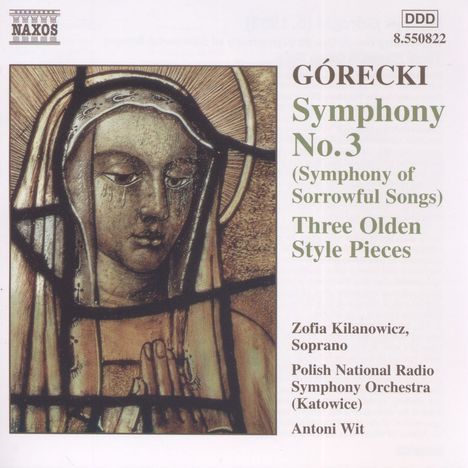Henryk Mikolaj Gorecki: Symphonie Nr.3 "Symphonie der Klagelieder" auf CD
Symphonie Nr.3 "Symphonie der Klagelieder"
Herkömmliche CD, die mit allen CD-Playern und Computerlaufwerken, aber auch mit den meisten SACD- oder Multiplayern abspielbar ist.
Lassen Sie sich über unseren eCourier benachrichtigen, falls das Produkt bestellt werden kann.
+3 Stücke im alten Stil
- Künstler:
- Zofia Kilanowicz, RSO Katowice, Antoni Wit
- Label:
- Naxos
- Aufnahmejahr ca.:
- 93
- UPC/EAN:
- 4891030508224
- Erscheinungstermin:
- 12.4.1994
Ähnliche Artikel
Die dritte Symphonie wurde zwischen Oktober und Dezember 1976 in Kattowitz geschrieben und der Frau Góreckis gewidmet. Sie wurde im darauf folgenden Jahr beim Avantgarde-Festival von Royan uraufgeführt. Der erste Satz beginnt mit einem Kanon für Streicher, der nach und nach durch die möglichen Orchesterregister aufgebaut wird, beginnend mit den Kontrabässen und steigert sich in Tonhöhe und Intensität, während jeder Teil in Nachahmung eintritt. Im Mittelpunkt des Satzes steht die polnische Klage des Klosters zum Heiligen Kreuz aus dem 15. Jahrhundert, in der die Mutter Christi ihren sterbenden Sohn bittet, zu ihr zu sprechen. Danach wird der Kanon wieder aufgenommen und sinkt, wie zuvor, in Tonhöhe und Intensität ab, um dann langsam in der einzigen melodischen Linie zu enden, dem Cantus firmus, mit dem der Satz begonnen hatte.
Der zweite und dritte Satz der Sinfonie sind zusammen genauso lang wie der erste Satz. Alle drei sind mit Lento bezeichnet, aber hinter dieser Richtung verbergen sich viele Nuancen des Tempos, zarte und subtile Tempowechsel. Der zweite Satz bietet einen unmittelbaren Kontrast zum düsteren, elegischen Ton des ersten Satzes. Die Worte des Liedes sind nichtsdestoweniger tragisch, ein Gebet, das ein achtzehnjähriges polnisches Mädchen, das den Schutz der Himmelskönigin sucht, an die Wand einer Gestapo-Zelle gekratzt hat. Die melodische Linie mit ihrer Begleitung aus gehäuften Klangfarben ist traurig, aber lyrisch in ihrer sanften Schönheit und berührt das Herz des Zuhörers zum Teil wegen ihrer textlichen und historischen Quelle, zu der die Musik eine noch größere Schärfe hinzufügt. Ein sich wiederholendes Motiv leitet den dritten Satz ein, mit seinem Volkslied, in dem eine Mutter den Verlust ihres Sohnes beklagt, dessen Körper sie nun sucht, wobei das eindringliche Ostinato des Orchesters eine melodische Linie von größter Einfachheit aufzeigt. Die Symphonie endet mit einem Ausdruck der Hoffnung, der dem von grausamen Feinden getöteten Jungen erlaubt, in Frieden zu ruhen, umgeben von den Singvögeln Gottes und den Blumen Gottes.
1963 schrieb Górecki Drei Stücke im alten Stil für Streichorchester, wobei er Elemente volkstümlichen Ursprungs mit neueren musikalischen Techniken kombinierte. Die drei Stücke, die in vielerlei Hinsicht etwas von der Stimmung und Technik der Dritten Symphonie andeuten, beginnen mit Musik, die allmählich an Intensität gewinnt. Auf ein schnelleres zweites Stück folgt ein Schlussstück, das die Stimmung der ersten wieder aufgreift.
Product Information
The Third Symphony was written in Katowice between October and December 1976 and dedicated to Górecki's wife. It was first performed at the avant-garde Festival of Royan the following year. The first movement opens with a canon for strings, building gradually through the possible orchestral register, starting with the double basses and mounting in pitch and intensity, as each part enters in imitation. At the heart of the movement is the 15th century Polish Lamentation of the Holy Cross Monastery, in which the Mother of Christ begs her dying Son to speak to her. After this the canon resumes, descending, as before it had risen, in both pitch and intensity, slowly unwinding to end with the single melodic line, the cantus firmus with which the movement had begun.
The second and third movements of the symphony together are as long as the first movement. All three are marked Lento, but this direction conceals many nuances of tempo, delicate and subtle changes of pace. The second movement offers an immediate contrast to the sombre elegiac tone of the first. The words of the song are none the less tragic, a prayer scratched on the wall of a Gestapo cell by an eighteen-year-old Polish girl seeking the protection of the Queen of Heaven. The melodic line, with its accompaniment of clustered sonorities, is sad but lyrical in its gentle beauty, touching the heart of the listener in part because of its textual and historical source, to which the music adds even greater poignancy. A repeated motif introduces the third movement, with its folk-song in which a mother laments the loss of her son, whose body she now seeks, the insistent ostinato of the orchestra pointing a melodic line of the greatest simplicity. The symphony ends with an expression of hope, allowing the boy, killed by cruel enemies, to rest in peace, lulled by God's song-birds and surrounded by the flowers of God.
In 1963 Górecki wrote Three Pieces in Olden Style for string orchestra, combining elements of folk origin with more recent musical techniques. The three pieces, which in many ways suggest something of the mood and technique of the Third Symphony, open with music that gradually builds in intensity. A quicker second piece is followed by a final piece that echoes the mood of the first.
Rezensionen
Classic CD 7/94: "Zofia Kilanowicz ist eine Solistin mit großer Intensität,und man spürt, wie sehr sie von den Worten betroffen ist. Diese CD ist ganz klar erste Wahl."Disk 1 von 1 (CD)
Sinfonie Nr. 3 op. 36 "Sinfonie der Klagelieder"
-
1 1. Lento - Sostenuto tranquillo ma cantabile
-
2 2. Lento e largo - Tranquilissimo
-
3 3. Lento - Cantabile semplice
3 Stücke im alten Stil
-
4 Nr. 1 (ohne Satzbezeichnung)
-
5 Nr. 2 (ohne Satzbezeichnung)
-
6 Nr. 3 (ohne Satzbezeichnung)









